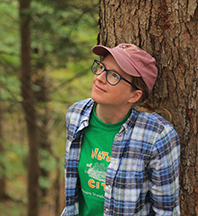Week of April 14, 2024 – April 20, 2024
by Anna Stunkel, Environmental Educator
A day of teaching the “Creatures of the Deep” Baltimore Woods Nature in the City lessons across Syracuse City Schools usually begins bright and early with a walk up to Phillips’ Pond. With two buckets and a net in tow, I allow some extra time to admire the forest and field waking up. Despite being a bird nerd, I’ve never been able to train my internal clock to be a natural morning person. But after getting up, I find morning to be such a beautiful time of day. Even on the brief walk I have recently experienced Fox Sparrow and Eastern Phoebe singing cheerily, Wood Ducks and Hooded Mergansers taking off from the pond with whirring wings, labyrinths of fox and cottontail tracks, and a chorus of Spring Peepers peeping and Wood Frogs quacking.
As I dip my net into the pond muck, each scoop brings up new finds. Critters bounce around in the net during a moment of surprise, then right themselves and resume swimming gracefully once placed gently into the buckets. After collecting six to eight species, the creature-filled buckets are loaded into the car on their way to the city.
When students learn that we brought animals today, they become especially giddy with excitement. Centipede-like hellgrammites crawl among the leaves, slimy snails leave trails in the buckets, backswimmers row around, caddisfly nymphs emerge slightly from their algal cases, and dragonfly nymphs stretch their legs back and jet around the water. Many have never seen animals like this so we are showing them a new and mysterious world – and they have so many questions as they watch and learn! How long do they live? What do they eat? Do they bite? They often give the creatures names and wish them well as they leave the classroom, heading back to their home at the pond.
Through this lesson, students gain an understanding that some communities in nature aren’t always visible at first glance, there is a quiet and secret world lying under its surface. The worlds above and below are intricately connected, which is why we must be careful not to dump pollution or litter into these creatures’ homes. Birds, frogs, and turtles depend on aquatic macroinvertebrates for food, too. Maybe next time they pass by a pond or stream, these students will peer into the depths to see if anyone is swimming along. Have you found any secretive communities in nature lately?


